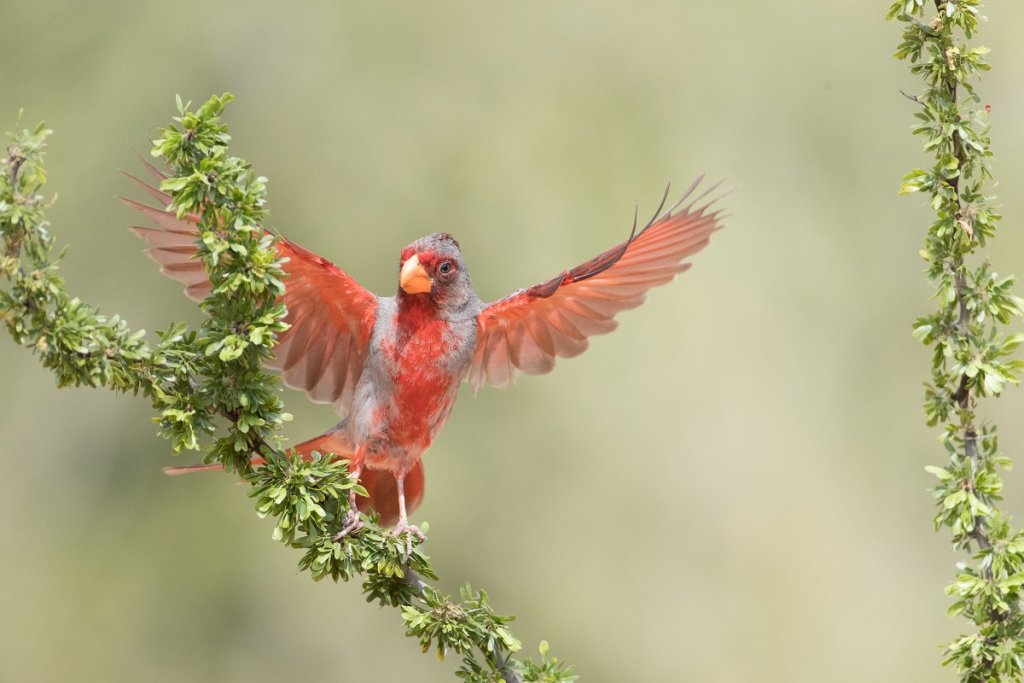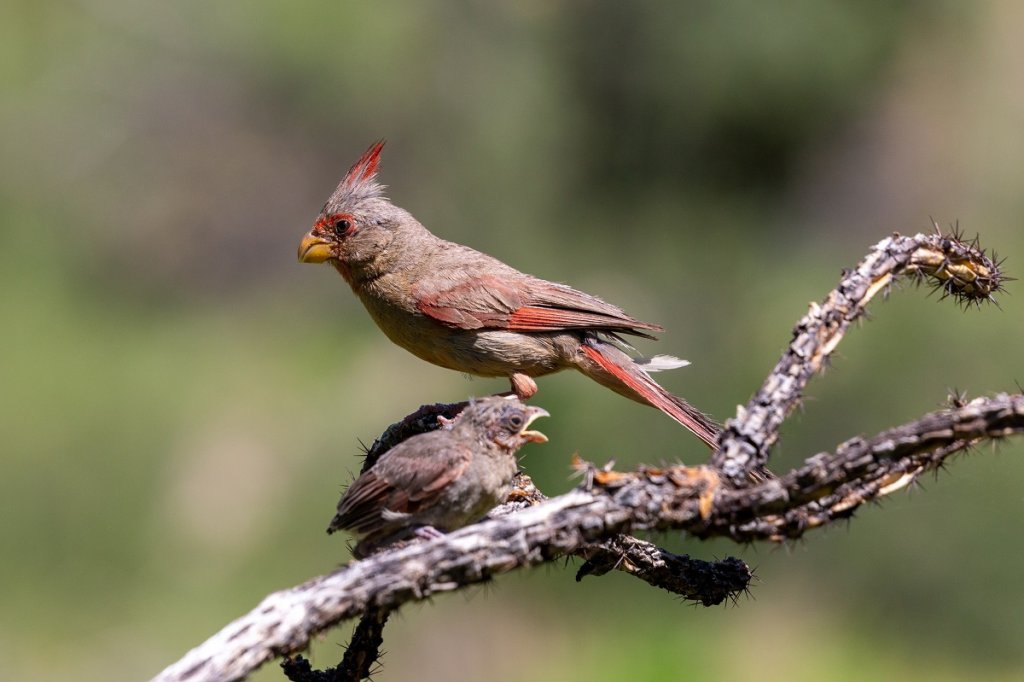The Pyrrhuloxia (Cardinalis sinuatus) or desert cardinal is a close relative of the northern cardinal. But this desert-dwelling North American bird species has evolved with its own unique nesting and mating rituals. With more subdued gray coloring. the bird has a red breast and mask.
A close relative of the northern cardinal, the pyrrhuloxia has more subtle coloring and a muted version of the same rich song. The desert-dwelling North American bird species (Cardinalis sinuatus) has evolved with its own unique nesting and mating rituals.
Sometimes called the desert cardinal, the pyrrhuloxia is a medium-sized songbird that lives in Mexico, New Mexico, Texas, and Arizona. Birdwatchers can find these hardy birds in desert scrub and amidst the thorny twigs of mesquite trees. While pyrrhuloxia shares much in common with the northern cardinal, there is much more to learn about the rarely seen pyrrhuloxia.
We’ll answer questions about nesting, mating rituals, and the range of the pyrrhuloxia. Then, we’ll dive into more details about this unique songbird. Read on to find out why the pyrrhuloxia is one of the most fascinating birds of North America.
Is the Pyrrhuloxia A Cardinal Bird Species?
The Pyrrhuloxia-Cardinalis sinuatus is closely related to the northern cardinal (Cardinalis cardinalis). Both bird species are part of the family Cardinalidae, although with a third member, the vermilion cardinal or Cardinalis phoeniceus. Adapted to the desert landscape it calls home, at first glance, the pyrrhuloxia doesn’t look like its iconic red feathered cousin at all. But there are a lot of similarities between these two bird species.
Northern cardinals are easily spotted with their bright red plumage, stunning red crest, and black face mask. In contrast, the desert cardinal is gray with a red face, crest, chest, wing tips, and tail. Female desert cardinals have gray chests and lack the red face of the male desert cardinal. Because of its grayish color, the pyrrhuloxia is sometimes confused with the female northern cardinal.
The color and bill shape of the two birds can help distinguish between an adult male desert cardinal and a female northern cardinal. Instead of a bright red beak like northern cardinals, the pyrrhuloxia has a yellow bill. The bill shape of the desert cardinal is also unique. It is slightly curved, giving the pyrrhuloxia a parrot-like bill shape.

Where Is The Pyrrhuloxia Found?
This desert cardinal prefers habitats ripe with desert scrubs and mesquite trees. The gray color helps the desert cardinal blend into its surroundings.
The desert cardinal range is much smaller than the vast North American range of the northern cardinal. Pyrrhuloxia is a non-migratory bird species found primarily in northern Mexico, New Mexico, Arizona, and Texas. In Mexico, the pyrrhuloxia is found in northern states and Baja California. Despite this limited range, the desert cardinal has often been spotted in Oklahoma and is even included in various Oklahoma field guides.
What Does The Pyrrhuloxia Song Sound Like?
The Pyrrhuloxia vocalizations are similar to the northern cardinal. The sound is slightly deeper, alternating between “tweet-tweet-tweet” and “chirp-chirp-chirp” phrases. Male Pyrrhuloxia perch high in trees and sing to protect territories and woo potential mates.
Desert cardinals are joyful singers, with the male pyrrhuloxia singing loud and often. Not only do they use song for choosing mates and protecting territories, singing is also a social activity. Like many songbirds, desert cardinals that live near one another tend to have a similar song. Meanwhile, the vocalizations of identical songbird species in different territories have their own unique phrasing.

What Are The Mating And Nesting Habits Of The Desert Cardinal?
Male desert cardinals vocalizations are used to defend breeding territory and find a mate. Like northern cardinals, male desert cardinals will perform a cardinal kiss to woo the female. Bringing her seeds, he will place the seed in her beak, which looks like a kiss. Once paired up, males share nest-building and parenting duties with the female.
Desert cardinals mate for life and use the same nesting sites year after year. Males bring nesting materials to the female, who builds the cup-shaped nest in low, dense shrubs. She lays 2-4 eggs greenish-white eggs with brown flecks per brood. A pair of desert cardinals can raise 1-3 broods per year.
Incubation lasts from 12 to 14 days. After hatching, both male and female desert cardinals bring food to the nestlings. Young desert cardinals fledge by 2 weeks old, but they spend an additional week near the nest. During this time, the parents will care for the baby on the ground, teaching it to fly and forage for food. Young desert cardinals stay near their parents until they are a year old when they are ready to start their own family.
What Does The Pyrrhuloxia Like To Eat?
Pyrrhuloxia love cactus fruits and various desert seeds. They also enjoy insects like caterpillars, beetles, and stick bugs. Male Pyrrhuloxia are known to catch and carry bugs to the nest to feed hatchlings.
The harsh environment the desert cardinal calls home leads to many opportunistic feeding behaviors. Along with foraging seeds, insects, and cactus fruit, desert cardinals are frequent visitors to backyard bird feeders. Like all cardinals, they prefer to platform feeders, tray feeders, or simply eating spilled seed from the ground. Desert cardinals will drink water but get most of their hydration from the food it eats.

Quick Pyrrhuloxia Facts
- The common name pyrrhuloxia comes from the part of the desert cardinal’s former scientific name. Pyrrhuloxia is a combination of the Latin word Pyrrhula (finches and bullfinches) and the Greek word Loxia (crossbills). Pyrrhos is also the Greek word for fire, which perfectly describes the red highlights over the gray feathers.
- During breeding season, desert cardinals are very territorial and stick to mating pairs or small flocks. During the winter, they are more social, running together in large flocks.
- While desert cardinals are territorial with other desert cardinals, desert cardinals and northern cardinals that live in the same regions don’t fight each other over territories.
- Northern cardinals have a short lifespan of around 3 years, but desert cardinals average about 8 years. This is due in part to the habitat of the desert cardinal. The harsh environment has far fewer domestic animals and less urban growth than the territory of northern cardinals.
- Though they don’t look very similar, grosbeaks and buntings are also part of the Cardinalidae family.
- Desert cardinals use plant fibers, rootlets, and even spider webs to line their nests!
The pyrrhuloxia or desert cardinal is an amazing bird. Despite the hard desert environment, this bird species calls home, they have managed to thrive, and their numbers are steady. The ways the desert cardinal has adapted to the desert, and the beautiful coloring make this bird species of the most unique birds of North America.

